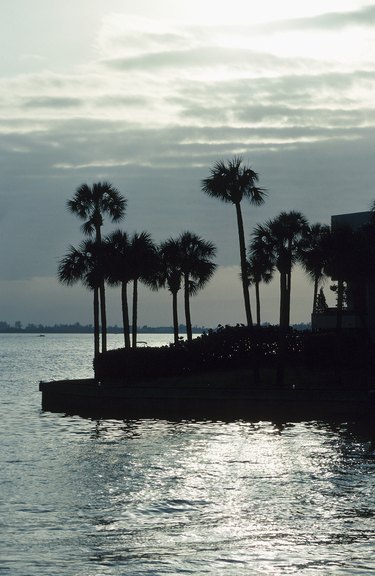
In 1953, the Florida State Legislature proclaimed the sabal palmetto palm (Sabal palmetto) the official state tree. Native south of a line from Jacksonville to Gainesville and Appalachicola, it's also colloquially called the cabbage or Florida sabal palm. The single-trunked palm can mature up to 40 feet tall with a rounded mop-headed canopy of fanlike fronds measuring 8 to 15 feet wide.
State Regulation Insight
Video of the Day
Florida Statute 15.031, dated 2010, but with historical origins in the 1953 statutes 1, 2, chapter 28126, proclaim the sabal palmetto palm as the state tree but does not limit its use or management. Therefore, wild palms continue to be dug up and harvested by landscapers for transplanting in residential and public landscapes. In the eyes of the state, you can cut down the state tree on your own legally owned property. However, county, municipal or homeowners association laws can still prohibit cutting down the palm.
Video of the Day
Research
Contact your lowest legal governing body or jurisdiction of your property to research whether any statue, code, ordinance or law restricts cutting down extant trees, including palms, from your Florida tract. Beyond a homeowners association-guided development, a city or county office would inform of any regulation about cutting down plants. Unless the regulation states with unambiguity that the Florida sabal palmetto palm cannot be cut down on private property, you are likely free to move forward. Thoroughly exhaust investigation through all applicable layers of governance over your property to ensure no current or old, abandoned laws do not remain that could haunt your decision to cut down the palm. For example, some loosely interpreted laws could equate a palm with a shade tree, and thereby regulate its removal under multiple rules.
Removal Insight
Once the top growth tip on the trunk of a sabal palm is removed, the plant effectively dies. Sabal palms do not rejuvenate after the canopy is fully cut off; no new growing tip emerges from the trunk as a replacement. Palm trunks are thick and very fibrous. It will not cut as easily or cleanly as a hardwood tree if old, dry frond bases called boots persist around the trunk. Chainsaw blades need frequent cleaning to rid the build up of juicy fibers. Use a sharp chain for cutting, as the fibers and sap can dull the blades quickly.
Options Besides Cutting Down
If cutting down the sabal palm is too laborious or you wish to save the palm but remove it from your property, contact a local landscaping company. If it specializes in landscape installation, workers may gladly dig and remove the palm for transplanting to a garden landscape. Consult with the company to reach a mutually agreement over an equal trade of no charge to buy the palm if the company does not charge for its digging and removal. Discuss options and any costs for filling the hole left from the palm's removal.